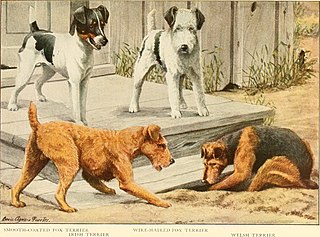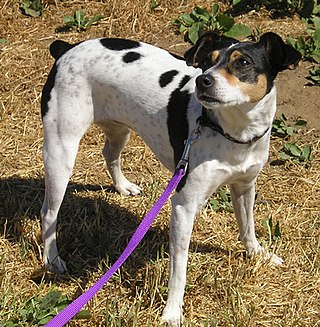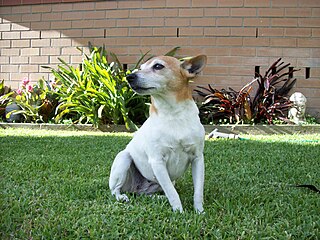
Terrier is a type of dog originally bred to hunt vermin. A terrier is a dog of any one of many breeds or landraces of the terrier type, which are typically small, wiry, game, and fearless. There are five different groups of terrier, with each group having different shapes and sizes.

The Jack Russell Terrier is a British breed of small terrier. It is principally white-bodied and smooth-, rough- or broken-coated, and can be any colour.

The Patterdale Terrier is a breed "type" of dog descended from the Northern terrier breeds of the early 18th century. Bred in Patterdale, Lake District.

Fox Terriers are two different breeds of the terrier dog type: the Smooth Fox Terrier and the Wire Fox Terrier. Both of these breeds originated in the 19th century from a handful of dogs who are descended from earlier varieties of British terriers, and are related to other modern white terrier breeds. In addition, a number of breeds have diverged from these two main types of fox terrier and have been recognised separately, including the Jack Russell Terrier, Miniature Fox Terrier and Rat Terrier. The Wire and Smooth Fox Terriers share similar characteristics, the main differences being in the coat and markings. They have been successful in conformation shows, more prominently in America than their homeland.

The Rat Terrier is an American dog breed with a background as a farm dog and hunting companion. They share much ancestry with the small hunting dogs known as feists. Common throughout family farms in the 1920s and 1930s, they are now recognized by the United (UKC) and American Kennel Clubs (AKC) and are considered a rare breed. Rat Terriers are an intelligent and active breed that can be kept both for pest control and as a family pet.

The Sealyham Terrier is a rare Welsh breed of small to medium-sized terrier that originated in Wales as a working dog. It is principally a white-bodied, rough-coated breed, developed in the mid-to-late-19th century by Captain John Edwardes at Sealyham House, Pembrokeshire.

The Lakeland Terrier is a dog breed, which takes its name from its place of origin, the Lake District in England. The dog is a small to mid-size member of the Terrier family. While independent in personality, it interacts well with owners and all family members, and is mostly hypo-allergenic. In the United Kingdom, the Lakeland Terrier is considered a vulnerable dog breed at risk of going extinct through low levels of breeding, according to The Kennel Club. In the United States, the Lakeland Terrier ranked 148 out of 193 breeds by number of American Kennel Club puppy registrations in 2019.

The Miniature Fox Terrier is a small, fine, lightweight working terrier developed as a hunting dog and vermin router. It is known colloquially in its native Australia as the “Mini Foxie”.

The Wire Fox Terrier is a breed of dog, one of many terrier breeds. It is a fox terrier, and although it bears a resemblance to the Smooth Fox Terrier, they are believed to have been developed separately. It originates from England.

The Teddy Roosevelt Terrier is a small to medium-sized American hunting terrier. It is lower-set, with shorter legs, and is more muscular with heavier bone density than the related American Rat Terrier. Much diversity exists in the history of the Teddy Roosevelt Terrier breed, and it shares a common early history with the American Rat Terrier, Fox Paulistinha, and Tenterfield Terrier. The Rat Terrier's background is said to stem from the terriers or other dogs that were brought over by early English and other working-class immigrants. Since the breed was a farm, hunting, and utility dog, little to no planned breeding was used other than breeding dogs with agreeable traits to each other to produce the desired work ethic in the dog. The Feist (dog), Bull Terrier, Smooth Fox Terrier, Manchester Terrier, Whippet, Italian Greyhound, the now extinct English White Terrier, Turnspit Dog, and Wry-legged Terrier all share in the Teddy Roosevelt Terrier's ancestry. These early ratting terriers were then most likely bred to the Beagle or Beagle crossbred dogs and other dogs. Maximizing the influences from these various breeds provides the modern Teddy Roosevelt Terrier with a keen sense of awareness and prey drive, an acute sense of smell, and a very high intellect. Although they tend to be aloof with strangers, they are devoted companion dogs with a strong desire to please and be near their owners at all times.

The Jagdterrier is a type of working terrier, originating in Germany, that is used for hunting quarry both above and underground. This breed of terrier is also called the German Hunt Terrier.

An earthdog test or earthdog trial tests the working ability and instinct of the small, often short-legged terriers or Dachshunds. These dogs were bred to hunt vermin and other quarry which lived in underground dens. Earthdog den tests involve human-made tunnels that the dogs must navigate, while scenting a rat, "the quarry". The dog must follow the scent to the quarry and then "work" the quarry. Depending on the sanctioning organization, "working" means barking, scratching, staring, pawing, digging; any active behavior. The quarry is protected at all times by wooden bars across the end of the tunnel. The hunting encounter is controlled, and neither the dog nor the quarry are endangered by the activity.

Bull and terrier was a common name for crossbreeds between bulldogs and terriers in the early 1800s. Other names included half-and-halfs and half-breds. It was a time in history when, for thousands of years, dogs were classified by use or function, unlike the modern pets of today that were bred to be conformation show dogs and family pets. Bull and terrier crosses were originally bred to function as fighting dogs for bull- and bear-baiting, and other popular blood sports during the Victorian era. The sport of bull baiting required a dog with attributes such as tenacity and courage, a wide frame with heavy bone, and a muscular, protruding jaw. By crossing bulldogs with various terriers from Ireland and Great Britain, breeders introduced "gameness and agility" into the hybrid mix.

A feist is a small hunting dog, descended from the terriers brought over to the United States by British miners and other immigrants. These terriers probably included crosses between the Smooth Fox Terrier, the Manchester Terrier, and the now-extinct English White Terrier. These dogs were used as ratters, and gambling on their prowess in killing rats was a favorite hobby of their owners. Some of these dogs have been crossed with Greyhounds, Whippets or Italian Greyhounds, and Beagles or other hounds —extending the family to include a larger variety of purpose than the original ratter, or Rat Terrier.

A working terrier is a terrier bred to hunt small mammals, such as badgers or foxes. According to the Oxford English Dictionary, the name dates back to 1425 and is derived from the French chien terrier, 'digging dog', which is from Medieval Latin terrarius, ultimately from Latin terra (earth).

The Drever is a breed of dog, a short-legged scenthound from Sweden used for hunting deer and other game. The Drever is descended from the Westphalian Dachsbracke, a type of German hound called Bracke. The breed name Drever was chosen through a contest in 1947.

Dog types are broad categories of domestic dogs based on form, function, or style of work, lineage, or appearance. Some may be locally adapted dog types that may have the visual characteristics of a modern purebred dog. In contrast, modern dog breeds strictly adhere to long-established breed standards, that began with documented foundation breeding stock sharing a common set of inheritable characteristics, developed by long-established, reputable kennel clubs that recognize the dog as a purebred.

The Sporting Lucas Terrier is a small breed of dog of the terrier type. The breed is named for Jocelyn Lucas.

The Lucas Terrier is a small breed of dog of the terrier type which originated in England in the late 1940s. The breed was created by Sir Jocelyn Lucas at his Ilmer Kennels in Watford, Hertfordshire. All living authentic examples can trace their ancestry back to a small number of his original Ilmer Sealyham dogs, and resulting Lucas Terrier progeny.
A ratter is any dog used for catching and killing rats and similar vermin. Specialized rat-catching breeds are found in many countries. A typical ratter is small to medium-sized and has a short and smooth coat, however a wide range of dog breeds and landraces may be used. The use of ratting dogs is widely considered to be the most environmentally friendly, humane and efficient methods of exterminating rodents. Ratting dogs are considered more efficient than domestic cats.



















